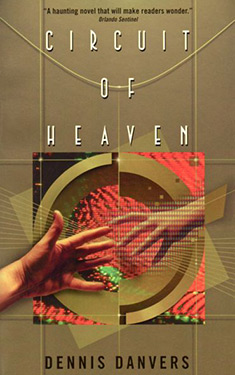
Added By: Engelbrecht
Last Updated: Administrator
Circuit of Heaven
| Author: | Dennis Danvers |
| Publisher: |
Avon, 1998 |
| Series: | |
|
This book does not appear to be part of a series. If this is incorrect, and you know the name of the series to which it belongs, please let us know. |
|
| Book Type: | Novel |
| Genre: | Science-Fiction |
| Sub-Genre Tags: | |
| Awards: | |
| Lists: | |
| Links: |
|
| Avg Member Rating: |
|
|
|
|
Synopsis
Nemo's mother and father left him behind to enter "the Bin"—joining twelve billion uploaded personalities who live in crime-free, disease-free and deathless virtual societies.
Nemo has come of age on a dangerous, near-deserted planet populated by a handful of stragglers: religious fundamentalists and rebels, the creeps and the crazies.
Now he is twenty-one. And on a rare, reluctant visit to the parents who abandoned flesh and son for cyber-utopia, Nemo has met the perfect woman: a new Bin arrival named Justine, a beautiful pop singer who dreams other people's dreams in the virtual night.
Excerpt
Prologue
Newman Rogers had been erratic lately, despondent, flying into a rage over nothing, working into
the wee hours of the morning. His coworkers would often find him sleeping on the sofa in the
waiting room when they came into work in the morning, or even slumped over his computer. He
was brilliant, a genius perhaps, but he was only one member of a team working to develop artificial
intelligence and was not thought to be indispensable. Whatever he was working on so
compulsively--he didn't share it with the rest of the team--soon prompted him to cease work
altogether on the job he was hired to do. Management was concerned.
And then, on a mid-December afternoon in 2020, he was fired for calling his supervisor an idiot.
He was thirty nine, well thought of until recently, but under the terms of his contract he couldn't
work on artificial intelligence research for any other firm for a period of two years, even though
every other firm would only be interested in him for such research.
None of this seemed to concern him, however. He holed up in his apartment and continued to
work, hacking his former employer's system late at night. A few months after his dismissal, he
published an obscure paper demonstrating, with a string of elegant proofs, that artificial intelligence
was impossible. He added, however, in a modest concluding paragraph, that it might be possible to
digitize human personality and, building on techniques already in use in medicine and virtual reality
simulations, transfer the personality to another organism, or even to another, more durable, medium
altogether.
While competing theorists flung themselves at his proofs like a pack of skilled dogs, a small group
of wealthy and aging businessmen contacted him and offered to finance his research. Suddenly he
found himself in charge of a team of researchers with almost limitless resources. In 2030, the first
practical application of his work, the transfer of the identity of a ninety-seven-year-old owner of a
large insurance company into the quick-grown clone of a healthy young man, was performed with
complete success. Even young men eventually die, however, and Newman was encouraged to
continue developing a more durable medium for human intelligence.
To help finance this venture, his backers, over his objections, marketed Constructs--humans made
from portions of several different personalities implanted into a cloned body--as servants and
laborers. To overcome customers' uneasiness with what some described as the new slavery, the
clones, with increasingly clever, even entertaining gene splices, were made to look as if they
weren't human. Unfortunately (and as Newman had predicted) the partial personalities that made up
each Construct reconstituted themselves over the years, remembering their former lives and
identities.
In 2040, Rogers succeeded in designing the Alternative Life Medium Assembly, ALMA for short, a
vast network of silicon crystals in which any number of human personalities might dwell in a world
they would experience as indistinguishable from the real world. The operating system could be
programmed to eliminate disease, violence, and death--and it would last forever. He had invented
paradise.
The new world government, shakily formed in 2036, sold the former site of the Pentagon for the
construction of ALMA, dubbed "the Bin" by the media, a nickname that stuck. In 2050 it went
on-line, and some half a million souls who could afford it entered their new world. In 2060, after
ten years of mounting pressure from residents of the real world, ALMA was opened up to everyone
eighteen years or older who did not scan as criminally insane. By 2074, the Supreme Court (the
majority of whom now re sided in the Bin) lifted the ban against minors, so that anyone, young and
old alike, might enter the Bin and live forever.
After a few years, the only people left in the real world were members of religious sects who
believed the Bin to be in violation of God's laws; the criminally insane; and a handful of persons
who, for one reason or another, stubbornly distrusted paradise. By 2080, the remaining population
of the real world, not counting Constructs, was about 2.5 million, though reliable figures were hard
to come by. The population of the Bin was over 12 billion.
As for Newman Rogers, the patron saint of ALMA, no one knew where he was or what he was
doing, though rumors were plentiful.
Copyright © 1998 by Dennis Danvers
Reviews
There are currently no reviews for this novel. Be the first to submit one! You must be logged in to submit a review in the BookTrackr section above.
Images
No alternate cover images currently exist for this novel.



















 Full Details
Full Details






